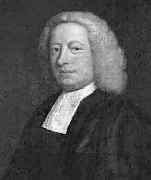Person: Colson, John

John Colson was an English clergyman and mathematician who translated several of Newton's books into Engish.
Mathematical Profile (Excerpt):
- John Colson matriculated at Christ Church College, Oxford, on 26 May 1699 but does not appear to have graduated with a degree.
- In 1707 Colson published The universal resolution of cubic and biquadratic equations viz.
- This was the most original piece of research that Colson produced in his whole career.
- Now at this point Colson came up with a clever idea that nobody seems to have thought of before this time.
- Colson tested each of these 9 possible solutions to see if it satisfies the original equation, and was able to identify the three actual solutions.
- This paper by Colson was the first to give all three solutions to a cubic equation.
- Colson was appointed as a master at the Sir Joseph Williamson Mathematical School in Rochester, Kent, in 1709.
- Colson was awarded a Master's Degree by the University of Cambridge in 1728 and, on 23 April of that year, he was elected a member of Emmanuel College.
- Colson continued as master at the Sir Joseph Williamson Mathematical School in Rochester and in 1737 he taught David Garrick (1717-1779) who went on to became a famous actor, producer, dramatist, and poet.
- In March 1739 Colson left Rochester when he was appointed as Taylor lecturer at Sidney Sussex College, Cambridge.
- There appears to have been only two candidates to fill the vacant Lucasian chair, Colson and Abraham De Moivre.
- Robert Smith really decided the election, and as de Moivre was very old and almost in his dotage he pressed the claims of Colson.
- Colson produced no further original mathematics, but did make a number of important translations and assisted in the publication of several texts.
- Each of these translations contained substantial commentary by Colson.
- In 1761, an edition of Newton's 'Arithmetica universalis' was published in Latin with Colson's commentary, also in Latin.
- Colson showed himself to be ahead of his times by his translation of 'Analyitical Institutions' written originally in Italian by Donna Maria Agnesi, a professor of mathematics and philosophy at the University of Bolgna.
- It was the first book on calculus written by a woman, and Colson intended the translation to make calculus more accessible to women.
- Colson had published Newton's (Latin) Fluxions in English, in 1736.
- It seems probable that Colson's two works of translation, of Newton and Agnesi, well served English students at large, and, despite opinions to the contrary, also provided a fluxional tool adequate for research.
Born 1680, Lichfield, Staffordshire, England. Died 20 January 1760, Cambridge, England.
View full biography at MacTutor
Tags relevant for this person:
Origin England
Thank you to the contributors under CC BY-SA 4.0! 

- Github:
-

- non-Github:
- @J-J-O'Connor
- @E-F-Robertson
References
Adapted from other CC BY-SA 4.0 Sources:
- O’Connor, John J; Robertson, Edmund F: MacTutor History of Mathematics Archive
